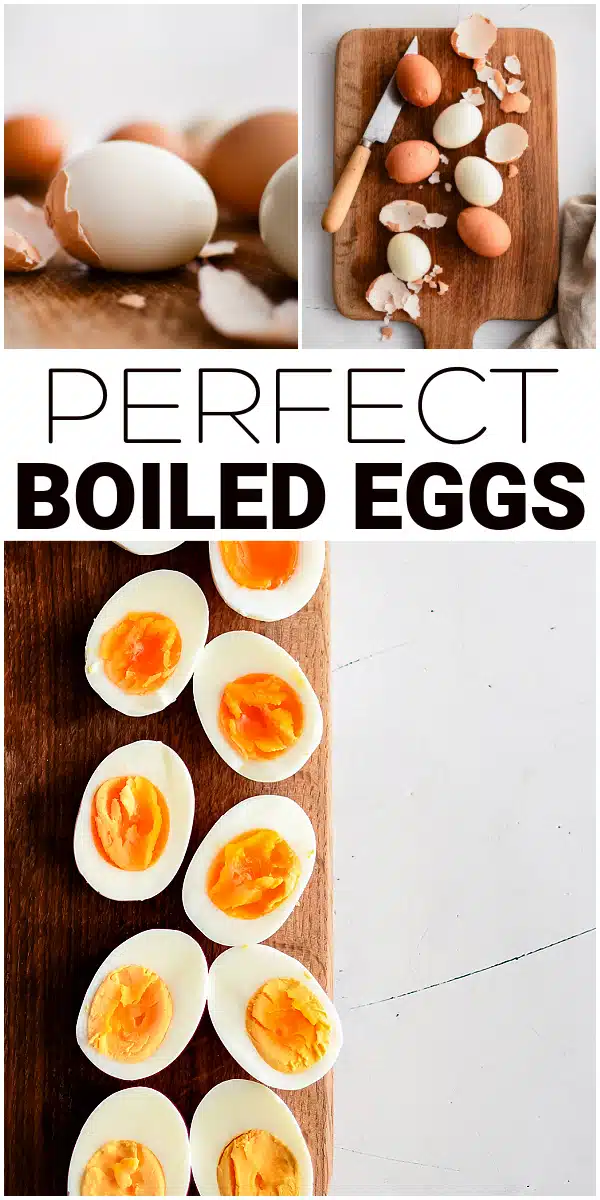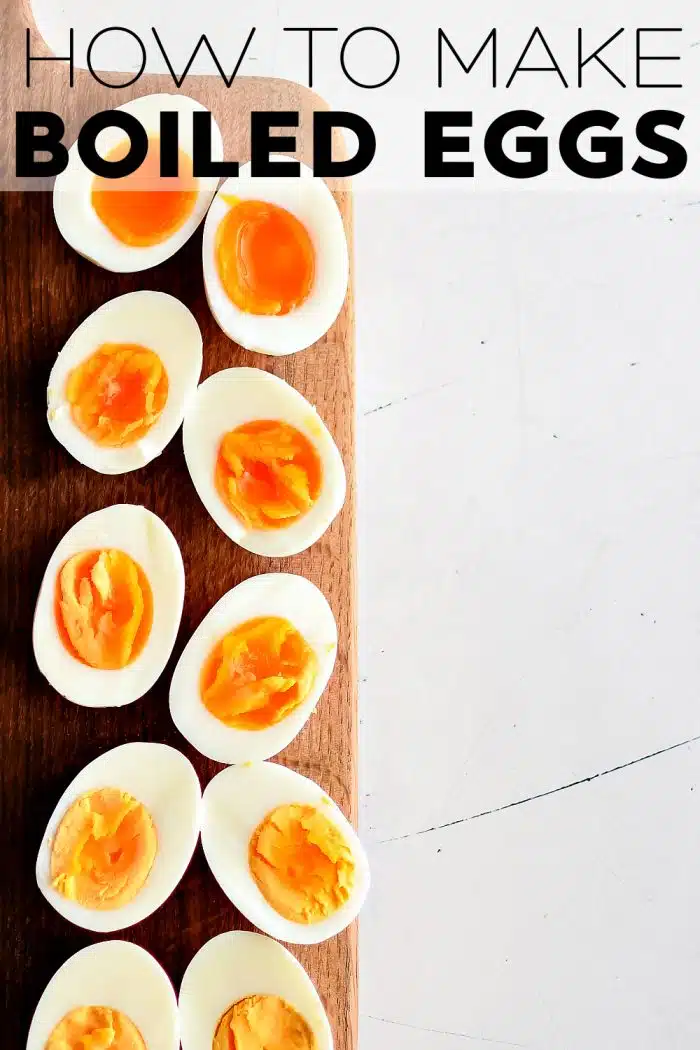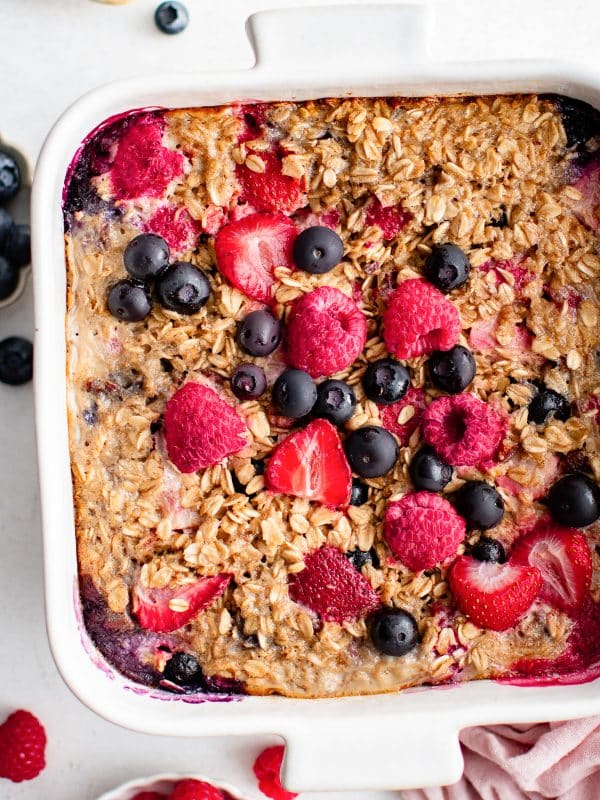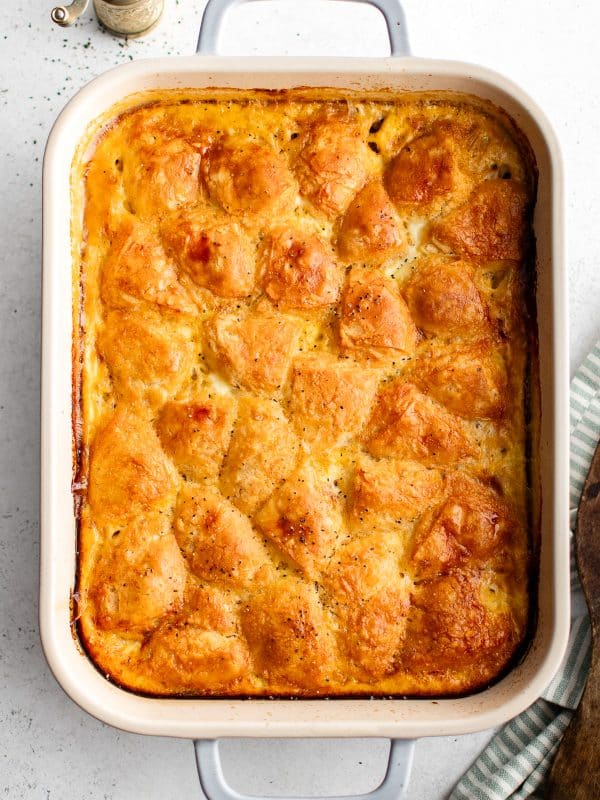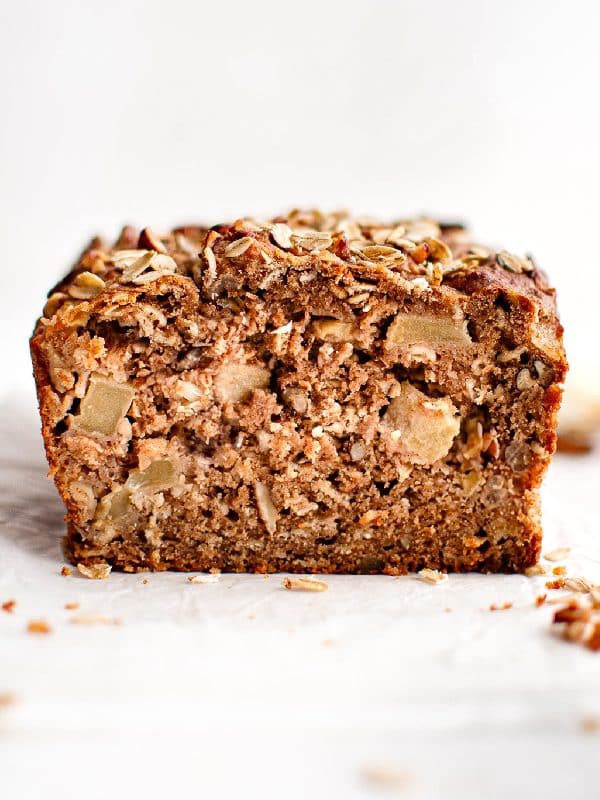This post may contain affiliate links. See my disclosure policy.
Learn How to Make Boiled Eggs on the stovetop with these simple steps in just 20 minutes or less! Serve your perfectly boiled eggs for breakfast or as a healthy snack, and add them to salads, sandwiches, and other favorite recipes!
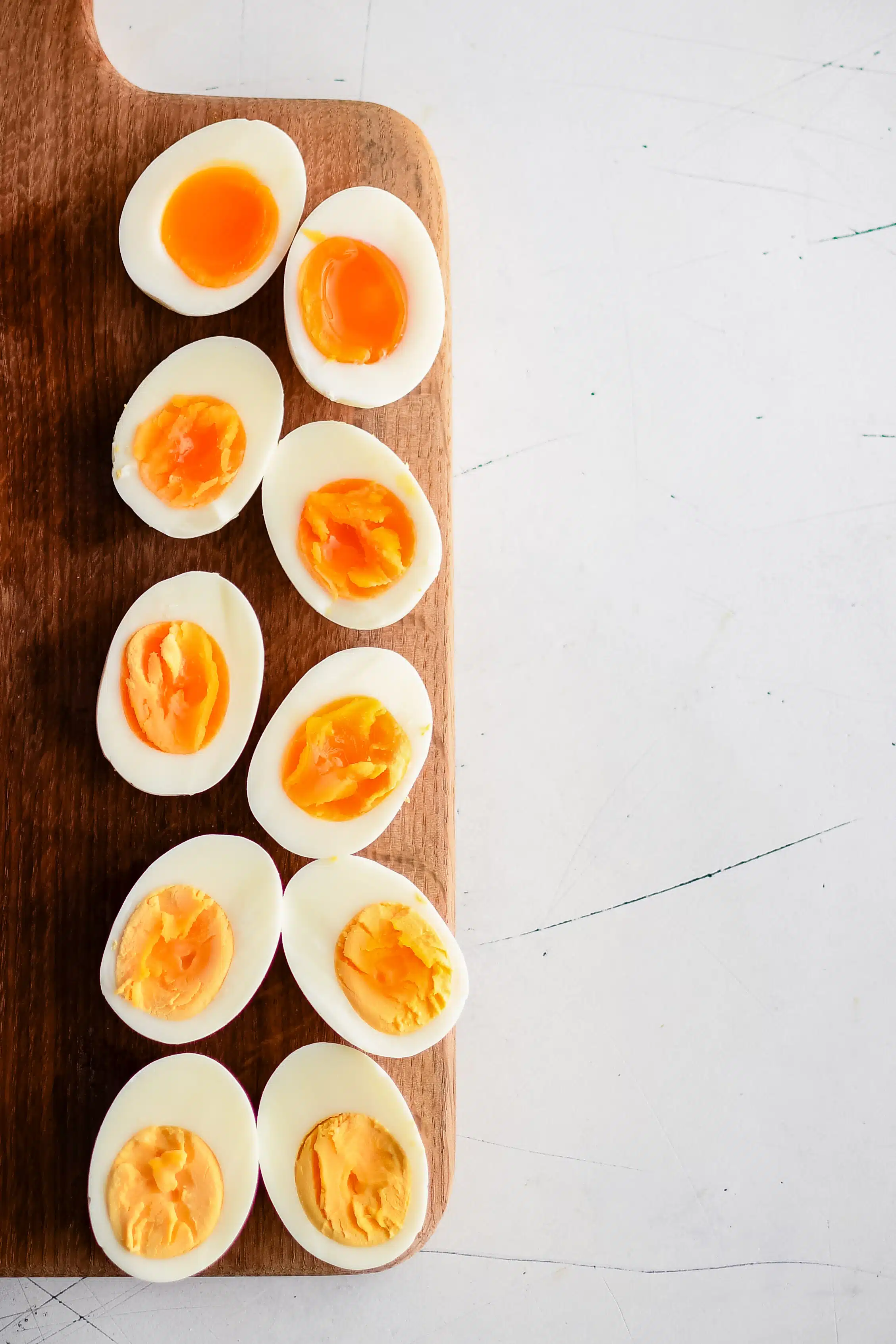
Table of Contents
- Perfect Hard Boiled Eggs Every Time
- How to Make Boiled Eggs
- Recipe Tips and Tricks
- What Other Methods Can I Use To Make Boiled Eggs?
- Are Soft-Boiled Eggs Safe to Eat?
- How Do I Prevent the Egg Shells From Sticking?
- How Long Do Hard-Boiled Eggs Last in the Refrigerator?
- What Are Some Ways to Use Hard-Boiled Eggs
- How to Boil Eggs Recipe
Perfect Hard Boiled Eggs Every Time
Why write a post on how to boil eggs, you ask? I mean, surely it’s a no-brainer! While the process itself isn’t lengthy or overly complicated, boiling eggs perfectly every time can be trickier than you think; at least, that’s been my experience.
Today, I’m going to walk you through how to make boiled eggs on the stovetop since this seems to be the most well-known and applied method used by people. Keep reading because I’m going to show you:
- How to use a time scale to get the perfect consistency of egg yolk in your boiled eggs depending on your preference;
- How to prevent common mistakes like egg cracking and overcooking;
- Delicious ways to use your boiled eggs;
- Other cooking methods you may not be familiar with!

How to Make Boiled Eggs
1. Prepare: Remove the eggs from the refrigerator and allow them to reach room temperature. Meanwhile, boil a large pot of water over high heat.
2. Cook the Eggs: Once the water starts boiling, slowly lower one egg at a time using a slotted spoon or sieve into the water, being careful not to drop the eggs into the pot so that they don’t crack. Boil the eggs for 6-12 minutes depending on how you like them done.
- 6-Minute Eggs: Runny yolk, barely set whites
- 7-9 Minute Eggs: Soft-boiled with jammy yolks and soft-set whites
- 10-Minute Eggs: Hard-boiled with fully cooked yolks and set whites
- 12-Minute Eggs: Max time to boil eggs before they become over-cooked
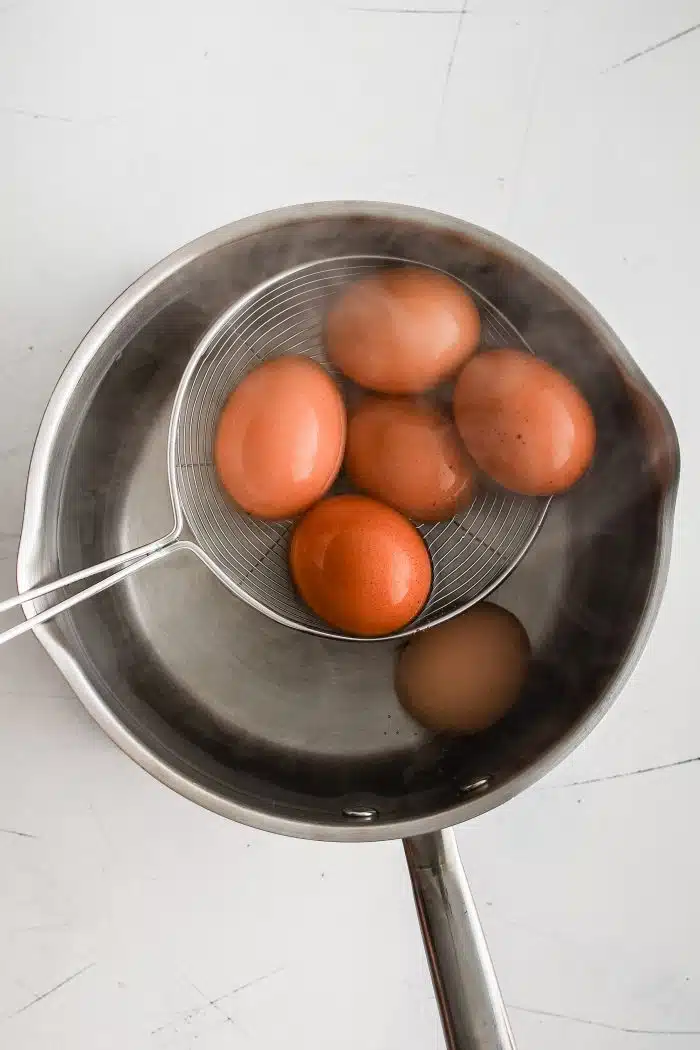
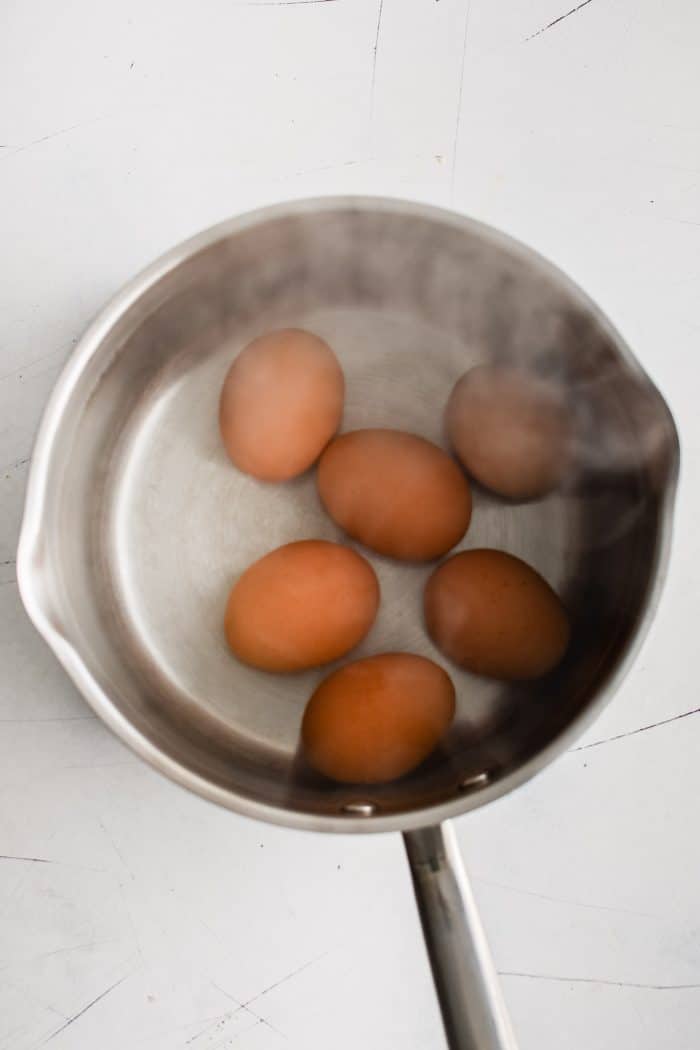
3. Ice Bath: Prepare an ice bath while the eggs are boiling. You’ll need a large bowl with ice and cold water. Remove the eggs from the pot with the slotted spoon and add them to the ice bath. Let the eggs cool in the ice bath for 10 minutes.
4. Crack, Peel, and Serve: Remove the eggs from the ice bath and tap them on a counter or against each other to crack the shells all the way around. Gently peel the shell under cold running water. Give them a final rinse to rid them of any small pieces of shell and slice them to serve with salt and freshly cracked black pepper.
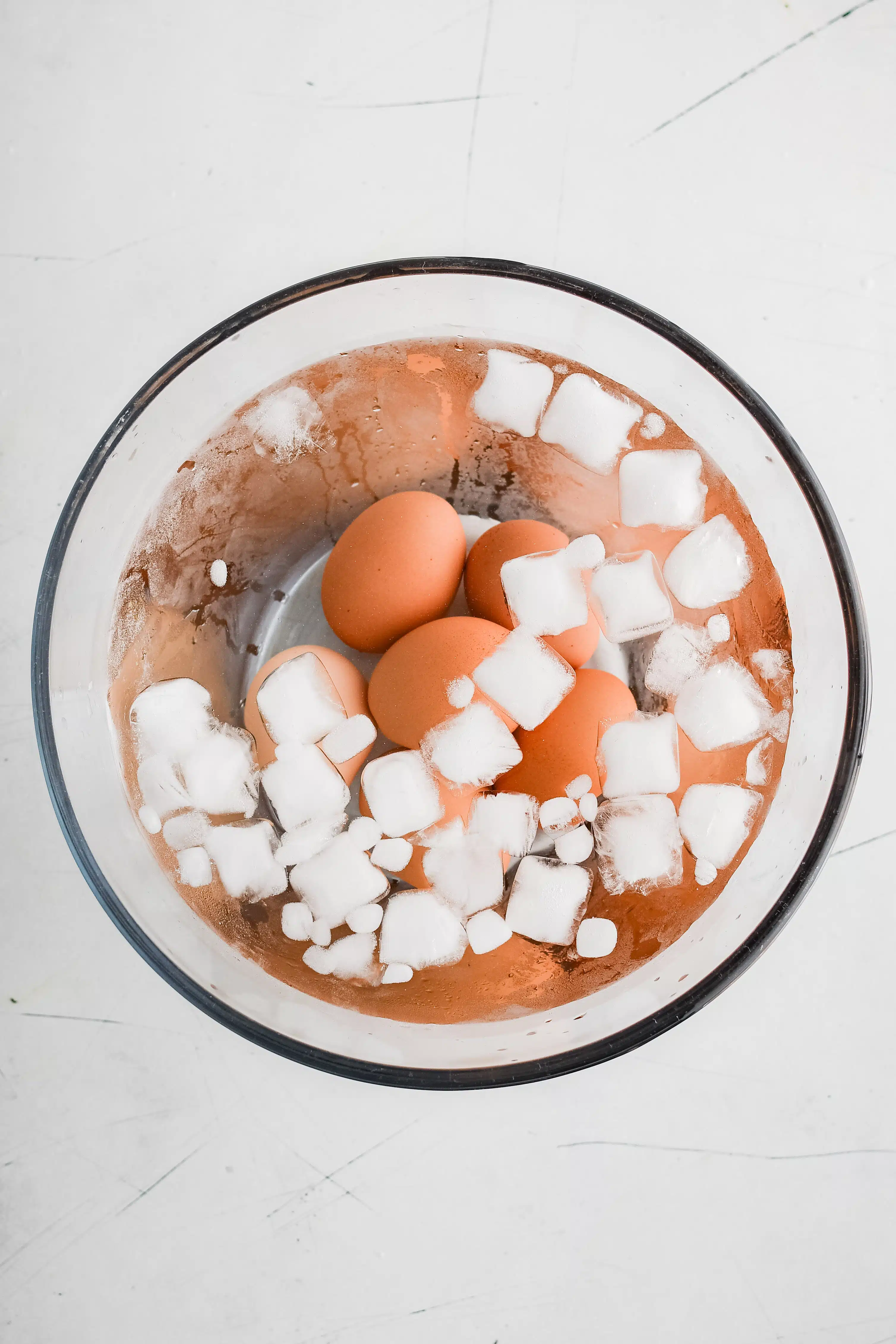
Recipe Tips and Tricks
- Bring the eggs to room temperature: The reason you want the eggs to reach room temperature before adding them to the boiling water is to reduce the sharp contrast of temperature between the water and the egg shells. If the eggs are still cold from the fridge, they are more likely to crack once added to the boiling water.
- Slowly lower the eggs into the pot: Slowly lowering your eggs into boiling water is another way to prevent the eggs from cracking. Never drop your eggs straight into the pot of boiling water.
- How do you like your eggs? Boil your eggs for 6 minutes if you enjoy a jammy, almost runny egg yolk consistency or up to 12 minutes if you prefer fully boiled eggs. Use this time scale as a guide to get your boiled eggs to the best consistency that you desire!
- Set a timer: While it may be tempting to check the kitchen clock, I highly recommend setting a timer when boiling eggs, especially when catering to family with a particular preference for how they like their boiled eggs done.
- Don’t skip the egg bath: Adding the boiled eggs to an ice bath helps to halt any further cooking of the eggs and makes it easier for you to peel away the shells without burning your fingers.
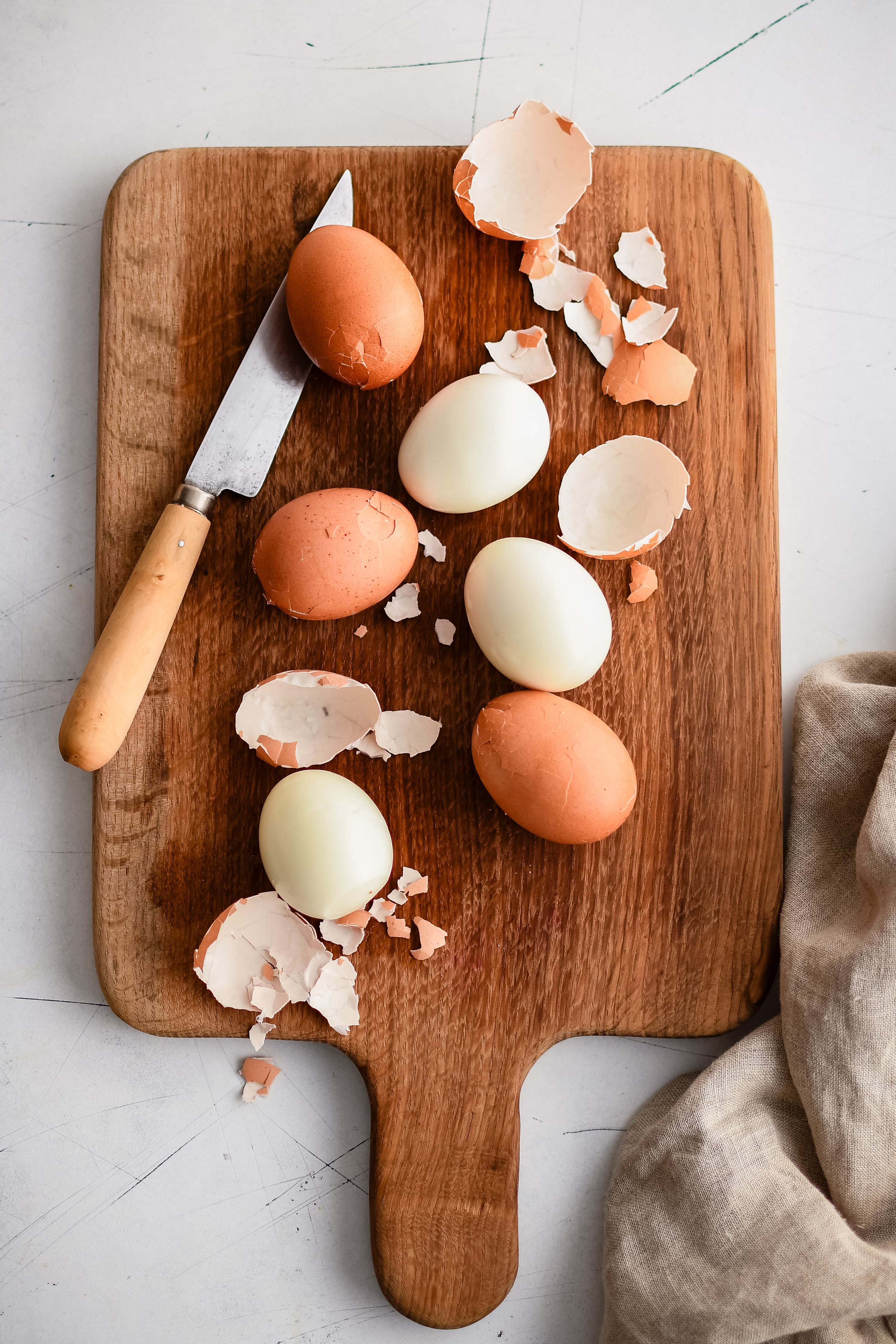
What Other Methods Can I Use To Make Boiled Eggs?
You can make Instant Pot boiled eggs, make eggs in an Air Fryer, or even in the oven! Here’s a quick overview of each method:
- Instant Pot: Add a cup of water to the inner pot and an egg or steamer basket. Place your eggs on the rack, fasten the lid, and cook on high for 5 minutes using the manual mode. Quick release after 5 minutes of natural release and transfer the eggs to an ice bath. Peel and serve.
- Air Fryer: Preheat the air fryer to 250 degrees F and place the eggs in the air fryer basket. Cook the eggs for 13-17 minutes, using this time scale to choose between softer or harder eggs. Remove the eggs and add them to an ice bath. Peel and serve.
- Oven: Preheat the oven to 325 degrees F. Place the eggs in a muffin tin and cook for 30 minutes. Remove the eggs and place them in an ice bath. Peel and serve.
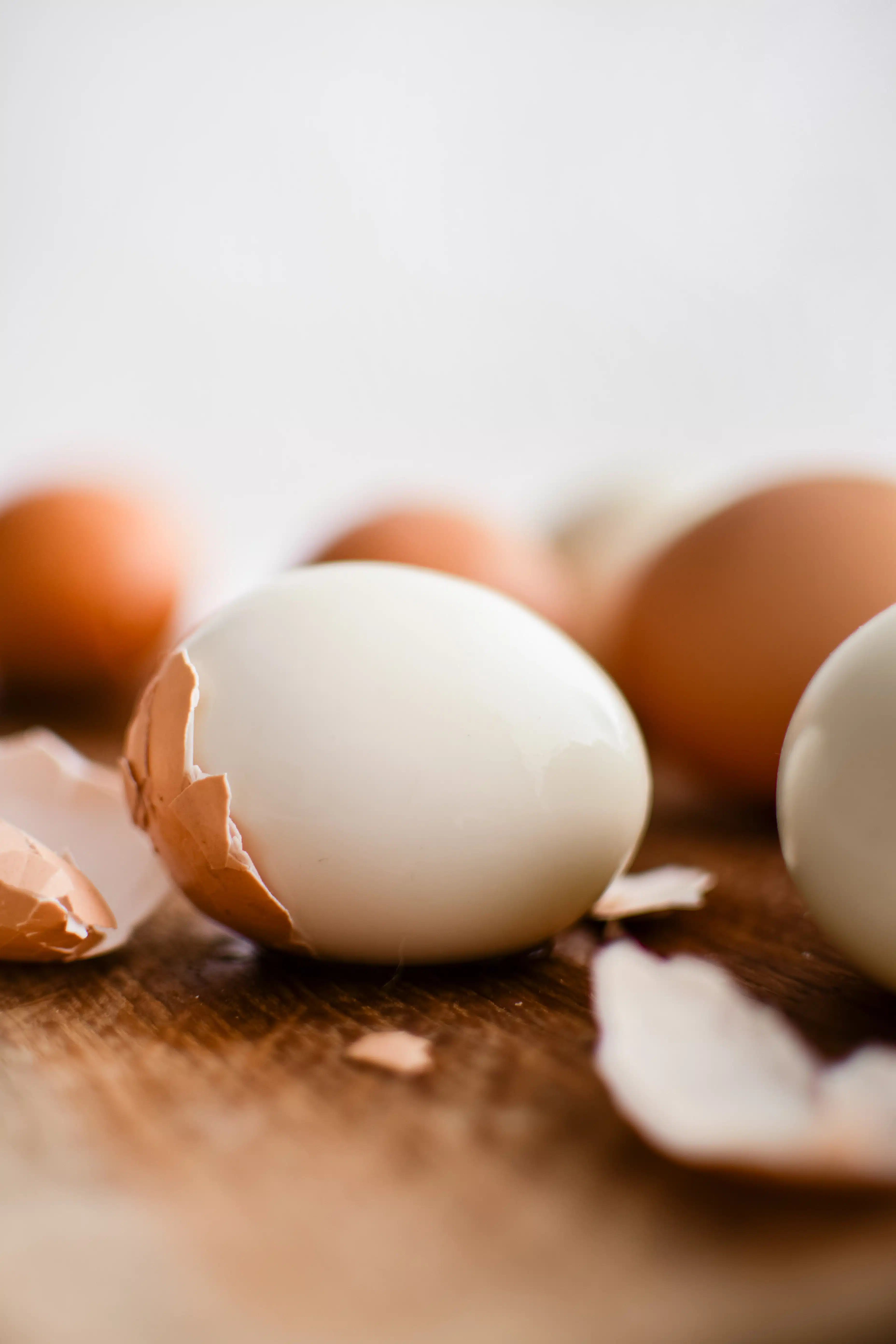
Are Soft-Boiled Eggs Safe to Eat?
If you love the runny yolk consistency in soft-boiled eggs but are concerned about the risk of foodborne illness, consider purchasing pasteurized eggs. Pasteurized eggs are heat-treated to kill bacteria without cooking the egg, making them safer to eat.
How Do I Prevent the Egg Shells From Sticking?
There is nothing worse than peeling a hard-boiled egg only to lose half of the egg white to the shell. The best solution to help ensure the shells come off more easily is to use older eggs (no, not OLD eggs). Older eggs are great for stove-top boiling.
Do a freshness test by placing an egg in a bowl of water. If it sinks to the bottom but stands upright, then you know it’s an older egg; meaning that it’s still safe to eat but should be eaten or cooked soon. Eggs that sink to the bottom and rest on their side are too fresh for these purposes while those that float are probably bad and should be discarded.

How Long Do Hard-Boiled Eggs Last in the Refrigerator?
Boiled eggs can be stored in an airtight container in the fridge for up to one week, peeled or unpeeled.
Reheat your refrigerated whole-boiled eggs in a bowl with very hot tap water for 2-3 minutes. Top off with additional hot water if needed. I don’t recommend reheating boiled eggs in the microwave unless they have been sliced in half. The internal pressure from the heat will cause the eggs to explode in the microwave.
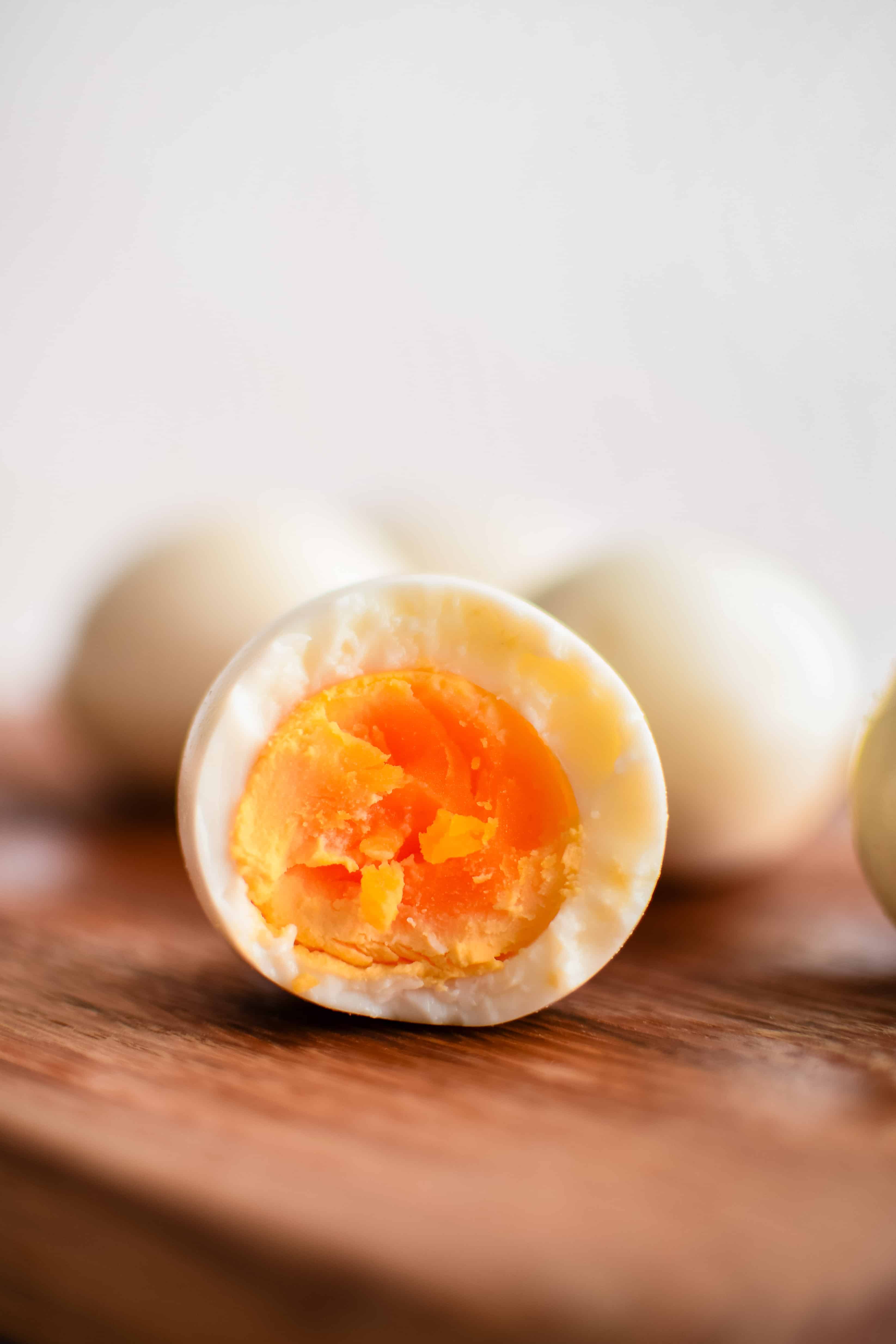
Can Hard Boiled Eggs be Frozen for Later Use?
Freezing is not recommended. The egg whites become rubbery and watery when frozen, then thawed.
What Are Some Ways to Use Hard-Boiled Eggs
Boiled eggs can be peeled, sliced in half, and seasoned with salt and freshly cracked black pepper and enjoyed on this avocado toast recipe or in a breakfast bowl. They also make tasty additions to Asian dishes like Miso Ramen, added to various salads, or used as lunchbox fillers. More delicious egg recipes include,
- Egg Salad Recipe
- Nicoise Salad
- Macaroni Salad
- Arroz Caldo Recipe (Filipino Chicken and Rice Porridge)
- Kimchi Ramen Noodle Soup
- 7 Layer Salad Recipe
- Birria Ramen
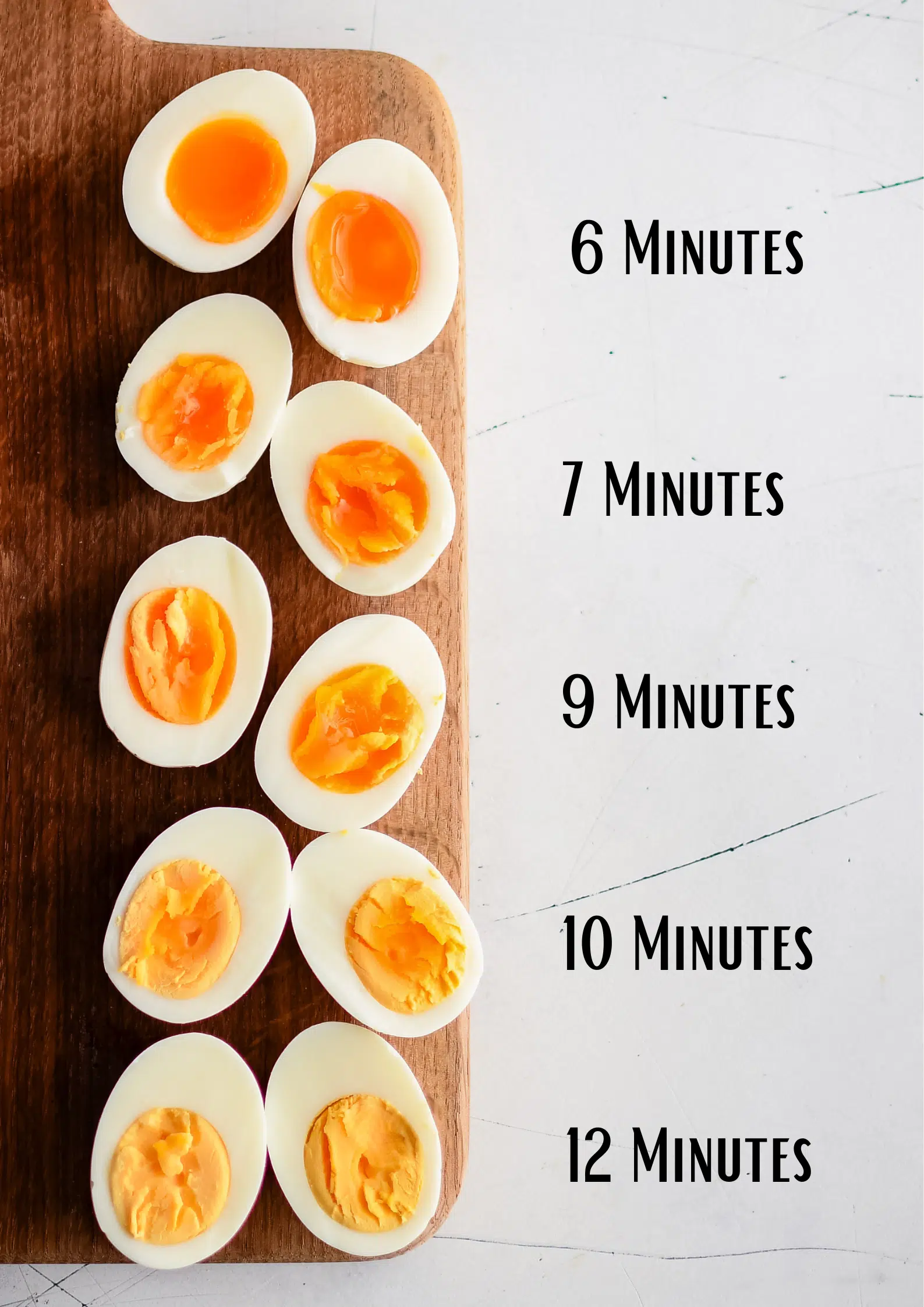
If you try making Boiled Eggs, please leave me a comment and let me know! I always love to hear your thoughts.

How to Boil Eggs
Instructions
- Bring a large pot of water to a boil over high heat (so that the eggs are covered with about 1 inch of water).
- Use a slotted spoon to slowly lower the eggs into the water so that none of them crack.
- Let them boil for 6-12 minutes according to how you like your yolks to be set. (Boiling for 6 minutes will give you jammy, almost runny yolks, and 12 minutes will give you fully boiled eggs. Use this time scale to get the perfect egg that you’re looking for.)
- While they boil, prepare an ice bath by adding ice to a large bowl and pouring in cold water.
- Use a slotted spoon to carefully remove the eggs from the pot and place them directly into the ice water bath. (I sometimes keep 6-7 minute boiled eggs in the slotted spoon and let the ice flash cool it so that it stops cooking and leaves the yolk jammy.)
- Allow the cooked eggs to cool completely for about 10 minutes then tap the egg on a counter or against each other to crack the shell all the way around.
- Gently peel away the shell, rinse then slice and serve with freshly cracked black pepper and salt if desired.
Notes
- Boiled eggs can last in an airtight container in the fridge for up to 7 days.
- Note: do not reheat boiled eggs in the microwave unless they are sliced. The pressure that builds up in the yolk will explode the egg and leave your microwave messy.
Nutrition
Nutrition information is automatically calculated, so should only be used as an approximation.
